MOCVD Growth of InGaAs/GaAs/AlGaAs Laser Structures with Quantum Wells on Ge/Si Substrates
Abstract
:1. Introduction
2. Growth of Ge Buffer Layer on Si Substrates
3. Growth of the A3B5 Nucleation Layer
4. Growth of A3B5 Laser Structures on Ge/Si Substrates with Various Ge Layer Thicknesses
5. InGaAs/GaAs/AlGaAs Laser Structures Grown by MOCVD on the Exact and Offcut Ge/Si(001) Substrates
6. The Growth of Laser Heterostructures with InGaAs Quantum Wells Emitting at Wavelengths Longer Than 1.1 μm
7. Conclusions
Author Contributions
Funding
Conflicts of Interest
References
- Sun, C.; Wade, M.T.; Lee, Y.; Orcutt, J.S.; Alloatti, L.; Georgas, M.S.; Waterman, A.S.; Shainline, J.M.; Avizienis, R.R.; Lin, S. Single-chip microprocessor that communicates directly using light. Nature 2015, 528, 534. [Google Scholar] [CrossRef] [PubMed]
- Liu, A.Y.; Zhang, C.; Norman, J.; Snyder, A.; Lubyshev, D.; Fastenau, J.M.; Liu, A.W.; Gossard, A.C.; Bowers, J.E. High performance continuous wave 1.3 μm quantum dot lasers on silicon. Appl. Phys. Lett. 2014, 104, 041104. [Google Scholar] [CrossRef]
- Chen, S.; Li, W.; Wu, J.; Jiang, Q.; Tang, M.; Shutts, S.; Elliott, S.N.; Sobiesierski, A.; Seeds, A.J.; Ross, I. Electrically pumped continuous-wave III–V quantum dot lasers on silicon. Nat. Photonics 2016, 10, 307. [Google Scholar] [CrossRef]
- Volz, K.; Beyer, A.; Witte, W.; Ohlmann, J.; Németh, I.; Kunert, B.; Stolz, W. GaP-nucleation on exact Si (0 0 1) substrates for III/V device integration. J. Cryst. Growth 2011, 315, 37–47. [Google Scholar] [CrossRef]
- Huang, X.; Song, Y.; Masuda, T.; Jung, D.; Lee, M. InGaAs/GaAs quantum well lasers grown on exact GaP/Si (001). Electron. Lett. 2014, 50, 1226–1227. [Google Scholar] [CrossRef]
- Liu, A.Y.; Peters, J.; Huang, X.; Jung, D.; Norman, J.; Lee, M.L.; Gossard, A.C.; Bowers, J.E. Electrically pumped continuous-wave 1.3 μm quantum-dot lasers epitaxially grown on on-axis (001) GaP/Si. Opt. Lett. 2017, 42, 338–341. [Google Scholar] [CrossRef] [PubMed]
- Tansu, N.; Mawst, L.J. High-performance strain-compensated InGaAs-GaAsP-GaAs (/spl lambda/= 1.17 μm) quantum well diode lasers. IEEE Photonics Technol. Lett. 2001, 13, 179–181. [Google Scholar] [CrossRef]
- Tansu, N.; Yeh, J.-Y.; Mawst, L.J. Low-threshold 1317-nm InGaAsN quantum-well lasers with GaAsN barriers. Appl. Phys. Lett. 2003, 83, 2512–2514. [Google Scholar] [CrossRef]
- Colace, L.; Masini, G.; Galluzzi, F.; Assanto, G.; Capellini, G.; Di Gaspare, L.; Palange, E.; Evangelisti, F. Metal–semiconductor–metal near-infrared light detector based on epitaxial Ge/Si. Appl. Phys. Lett. 1998, 72, 3175–3177. [Google Scholar] [CrossRef]
- Luan, H.-C.; Lim, D.R.; Lee, K.K.; Chen, K.M.; Sandland, J.G.; Wada, K.; Kimerling, L.C. High-quality Ge epilayers on Si with low threading-dislocation densities. Appl. Phys. Lett. 1999, 75, 2909–2911. [Google Scholar] [CrossRef]
- Yurasov, D.; Bobrov, A.; Daniltsev, V.; Novikov, A.; Pavlov, D.; Skorokhodov, E.; Shaleev, M.; Yunin, P. Impact of growth and annealing conditions on the parameters of Ge/Si (001) relaxed layers grown by molecular beam epitaxy. Semiconductors 2015, 49, 1415–1420. [Google Scholar] [CrossRef]
- Volkov, P.; Goryunov, A.; Luk’yanov, A.Y.; Tertyshnik, A.; Novikov, A.; Yurasov, D.; Baidakova, N.; Mikhailov, N.; Remesnik, V.; Kuzmin, V. Optical monitoring of technological parameters during molecular-beam epitaxy. Semiconductors 2012, 46, 1471–1475. [Google Scholar] [CrossRef]
- Souriau, L.; Atanasova, T.; Terzieva, V.; Moussa, A.; Caymax, M.; Loo, R.; Meuris, M.; Vandervorst, W. Characterization of threading dislocations in thin germanium layers by defect etching: Toward chromium and HF-free solution. J. Electrochem. Soc. 2008, 155, H677–H681. [Google Scholar] [CrossRef]
- Chia, C.; Dong, J.; Chi, D.; Sridhara, A.; Wong, A.; Suryana, M.; Dalapati, G.; Chua, S.; Lee, S. Effects of AlAs interfacial layer on material and optical properties of Ga As/Ge (100) epitaxy. Appl. Phys. Lett. 2008, 92, 141905. [Google Scholar] [CrossRef]
- Németh, I.; Kunert, B.; Stolz, W.; Volz, K. Heteroepitaxy of GaP on Si: Correlation of morphology, anti-phase-domain structure and MOVPE growth conditions. J. Cryst. Growth 2008, 310, 1595–1601. [Google Scholar] [CrossRef]
- Alcotte, R.; Martin, M.; Moeyaert, J.; Cipro, R.; David, S.; Bassani, F.; Ducroquet, F.; Bogumilowicz, Y.; Sanchez, E.; Ye, Z. Epitaxial growth of antiphase boundary free GaAs layer on 300 mm Si (001) substrate by metalorganic chemical vapour deposition with high mobility. Appl. Mater. 2016, 4, 046101. [Google Scholar] [CrossRef]
- Chriqui, Y.; Largeau, L.; Patriarche, G.; Saint-Girons, G.; Bouchoule, S.; Sagnes, I.; Bensahel, D.; Campidelli, Y.; Kermarrec, O. Direct growth of GaAs-based structures on exactly (0 0 1)-oriented Ge/Si virtual substrates: reduction of the structural defect density and observation of electroluminescence at room temperature under CW electrical injection. J. Cryst. Growth 2004, 265, 53–59. [Google Scholar] [CrossRef]
- Aleshkin, V.Y.; Baidus, N.; Dubinov, A.; Krasilnik, Z.; Nekorkin, S.; Novikov, A.; Rykov, A.; Yurasov, D.; Yablonskiy, A. On the stimulated emission of InGaAs/GaAs/AlGaAs laser structures grown by MOCVD on exact and inclined Ge/Si (001) substrates. Semiconductors 2017, 51, 663–666. [Google Scholar] [CrossRef]
- Aleshkin, V.Y.; Dikareva, N.; Dubinov, A.; Denisov, S.; Krasil’nik, Z.; Kudryavtsev, K.; Matveev, S.; Nekorkin, S.; Shengurov, V. Stimulated emission from an InGaAs/GaAs/AlGaAs heterostructure grown on a Si substrate. JETP Lett. 2015, 100, 795–797. [Google Scholar] [CrossRef]
- Aleshkin, V.Y.; Baidus, N.; Dubinov, A.; Fefelov, A.; Krasilnik, Z.; Kudryavtsev, K.; Nekorkin, S.; Novikov, A.; Pavlov, D.; Samartsev, I. Monolithically integrated InGaAs/GaAs/AlGaAs quantum well laser grown by MOCVD on exact Ge/Si (001) substrate. Appl. Phys. Lett. 2016, 109, 061111. [Google Scholar] [CrossRef]
- Kryzhanovskaya, N.; Moiseev, E.; Polubavkina, Y.S.; Maximov, M.; Kulagina, M.; Troshkov, S.; Zadiranov, Y.M.; Lipovskii, A.; Baidus, N.; Dubinov, A. Electrically pumped InGaAs/GaAs quantum well microdisk lasers directly grown on Si (100) with Ge/GaAs buffer. Opt. Express 2017, 25, 16754–16760. [Google Scholar] [CrossRef] [PubMed]
- Baidus, N.; Aleshkin, V.Y.; Dubinov, A.; Kudryavtsev, K.; Nekorkin, S.; Novikov, A.; Pavlov, D.; Rykov, A.; Sushkov, A.; Shaleev, M. Peculiarities of growing InGaAs/GaAs/AlGaAs laser structures by MOCVD on Ge/Si substrates. Semiconductor 2017, 51, 1527–1530. [Google Scholar] [CrossRef]
- Aleshkin, V.Y.; Baidus, N.; Dubinov, A.; Kudryavtsev, K.; Nekorkin, S.; Novikov, A.; Rykov, A.; Samartsev, I.; Fefelov, A.; Yurasov, D. Technology of the production of laser diodes based on GaAs/InGaAs/AlGaAs structures grown on a Ge/Si substrate. Semiconductor 2017, 51, 1477–1480. [Google Scholar] [CrossRef]
- Kroemer, H.; Polasko, K.J.; Wright, S.C. On the (110) orientation as the preferred orientation for the molecular beam epitaxial growth of GaAs on Ge, GaP on Si, and similar zincblende-on-diamond systems. Appl. Phys. Lett. 1980, 36, 763–765. [Google Scholar] [CrossRef]
- Sung, L.; Lin, H. Highly strained 1.24-μm InGaAs/GaAs quantum-well lasers. Appl. Phys. Lett. 2003, 83, 1107–1109. [Google Scholar] [CrossRef]
- Jung, D.; Norman, J.; Kennedy, M.; Shang, C.; Shin, B.; Wan, Y.; Gossard, A.C.; Bowers, J.E. High efficiency low threshold current 1.3 μ m InAs quantum dot lasers on on-axis (001) GaP/Si. Appl. Phys. Lett. 2017, 111, 122107. [Google Scholar] [CrossRef]
- Wan, Y.; Norman, J.; Li, Q.; Kennedy, M.; Liang, D.; Zhang, C.; Huang, D.; Zhang, Z.; Liu, A.Y.; Torres, A. 1.3 μm submilliamp threshold quantum dot micro-lasers on Si. Optica 2017, 4, 940–944. [Google Scholar] [CrossRef]
- Wang, J.; Hu, H.; Yin, H.; Bai, Y.; Li, J.; Wei, X.; Liu, Y.; Huang, Y.; Ren, X.; Liu, H. 1.3 μm InAs/GaAs quantum dot lasers on silicon with GaInP upper cladding layers. Photonics Res. 2018, 6, 321–325. [Google Scholar] [CrossRef]
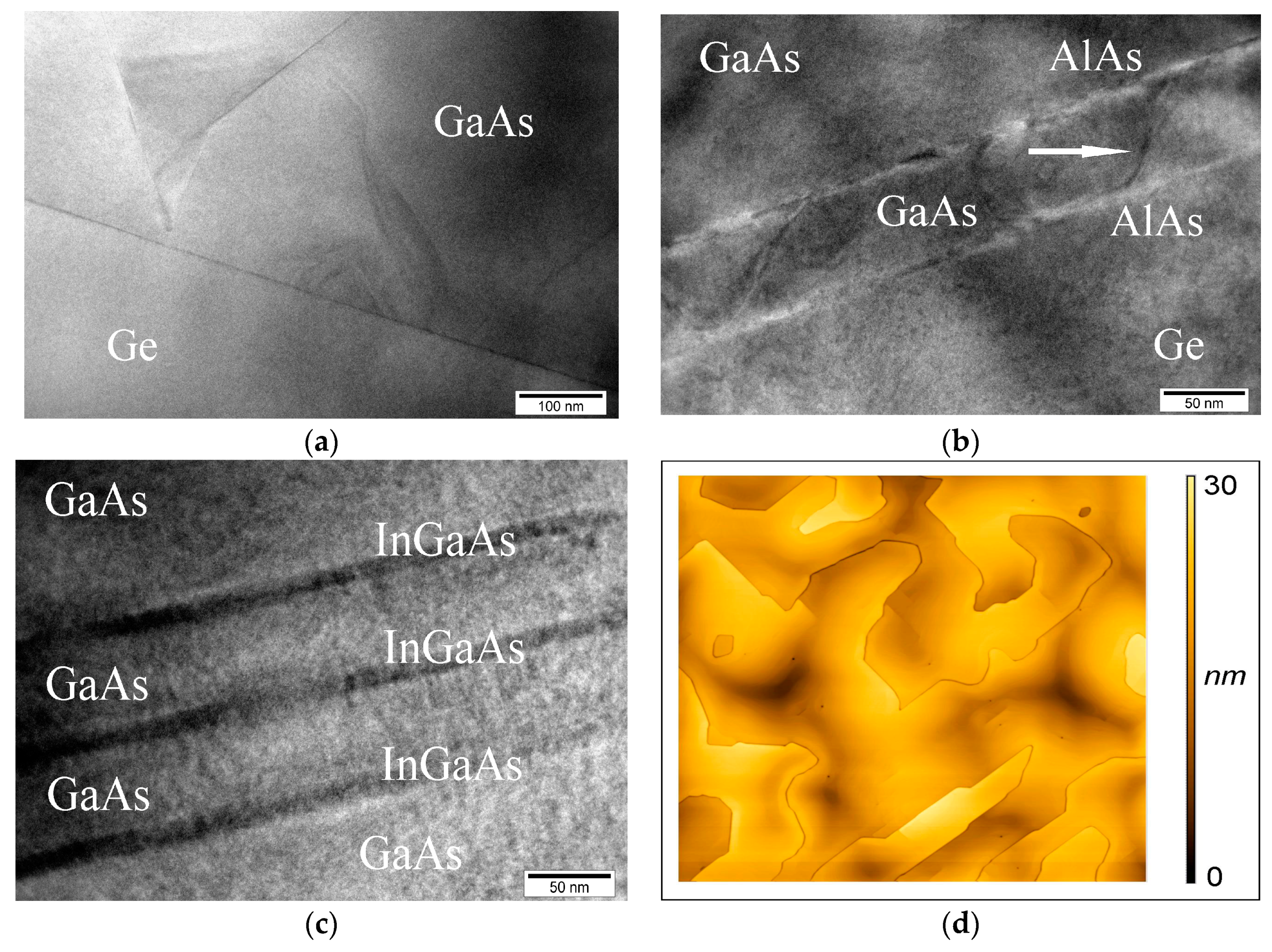
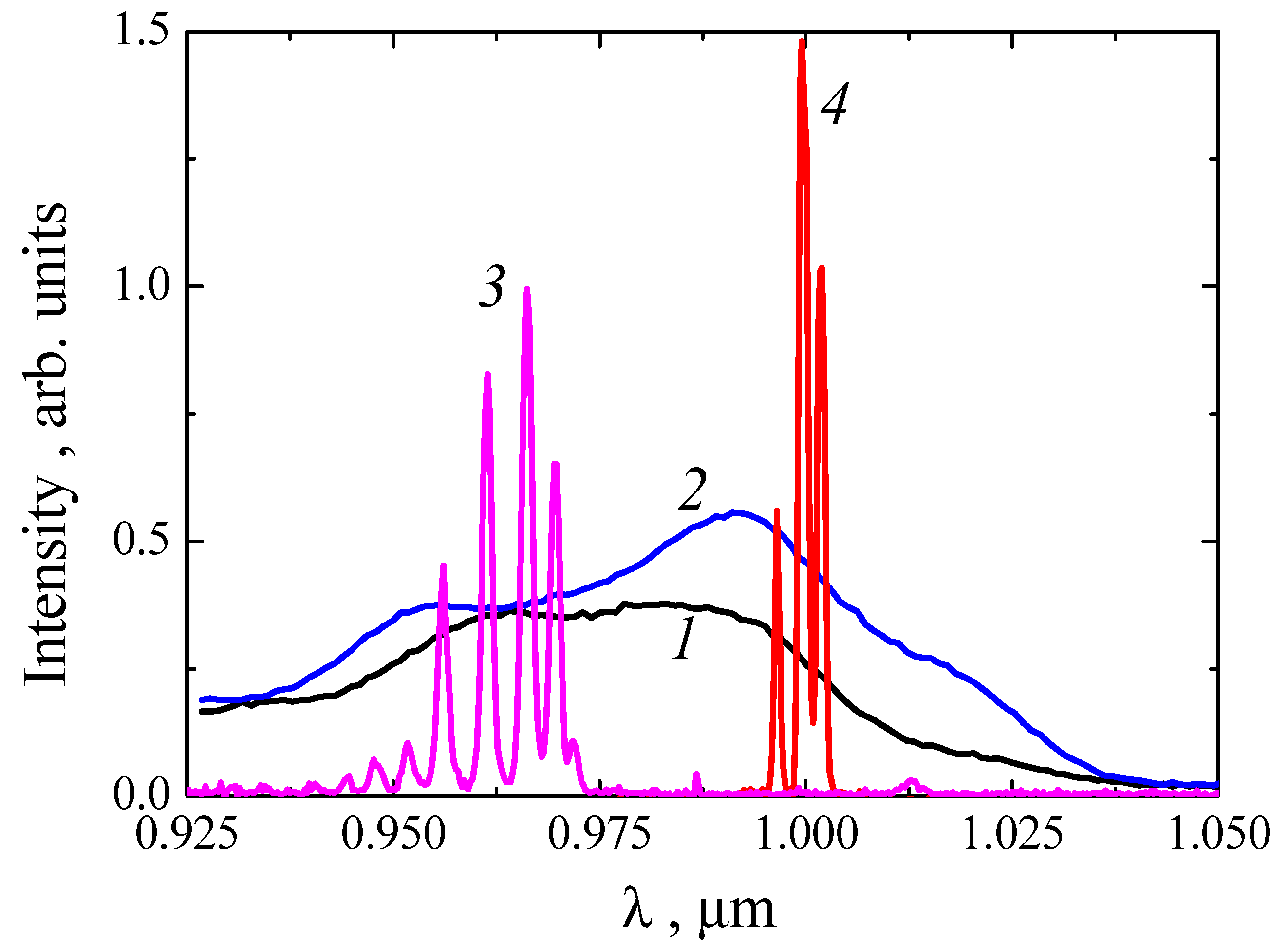
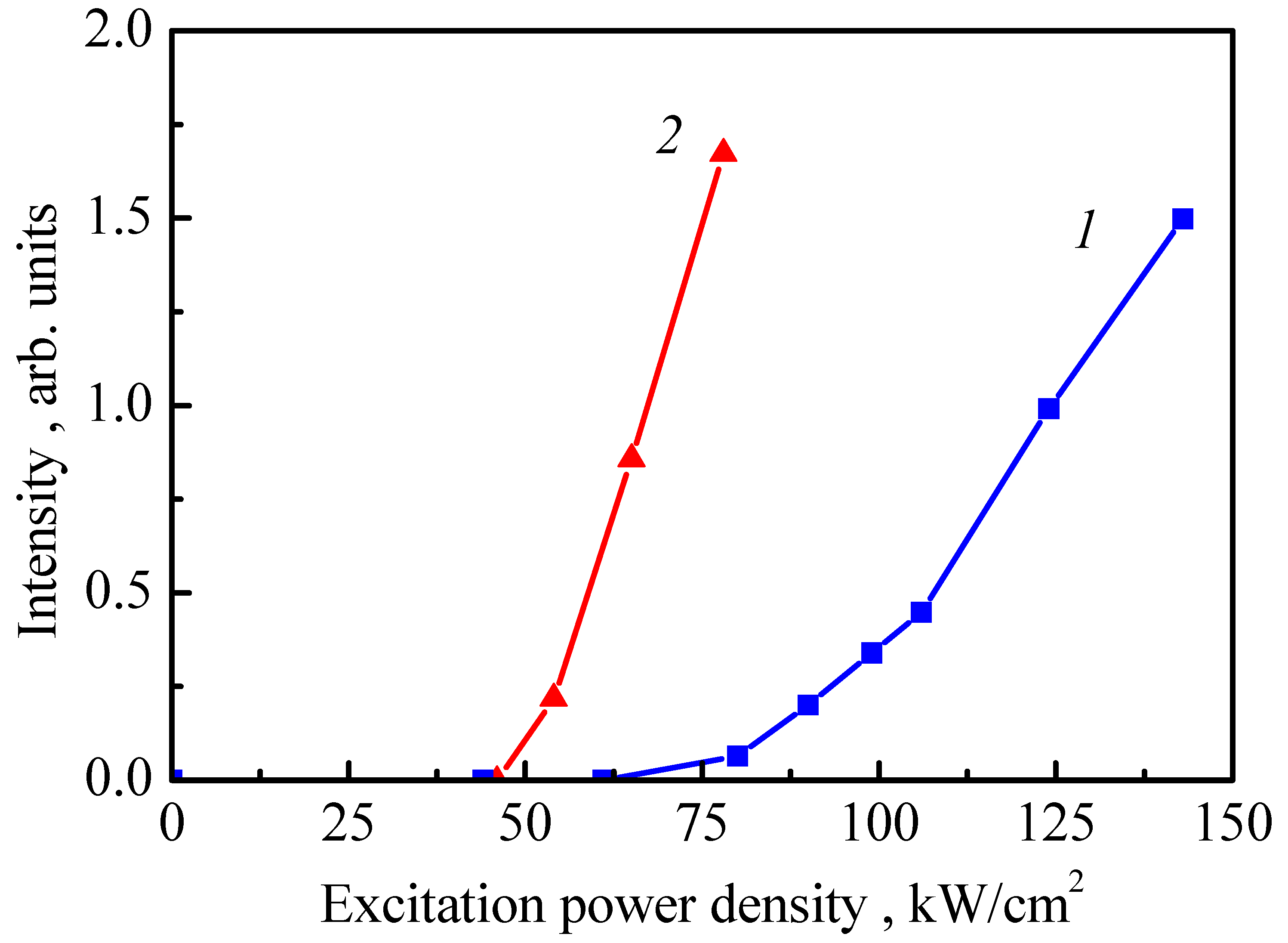
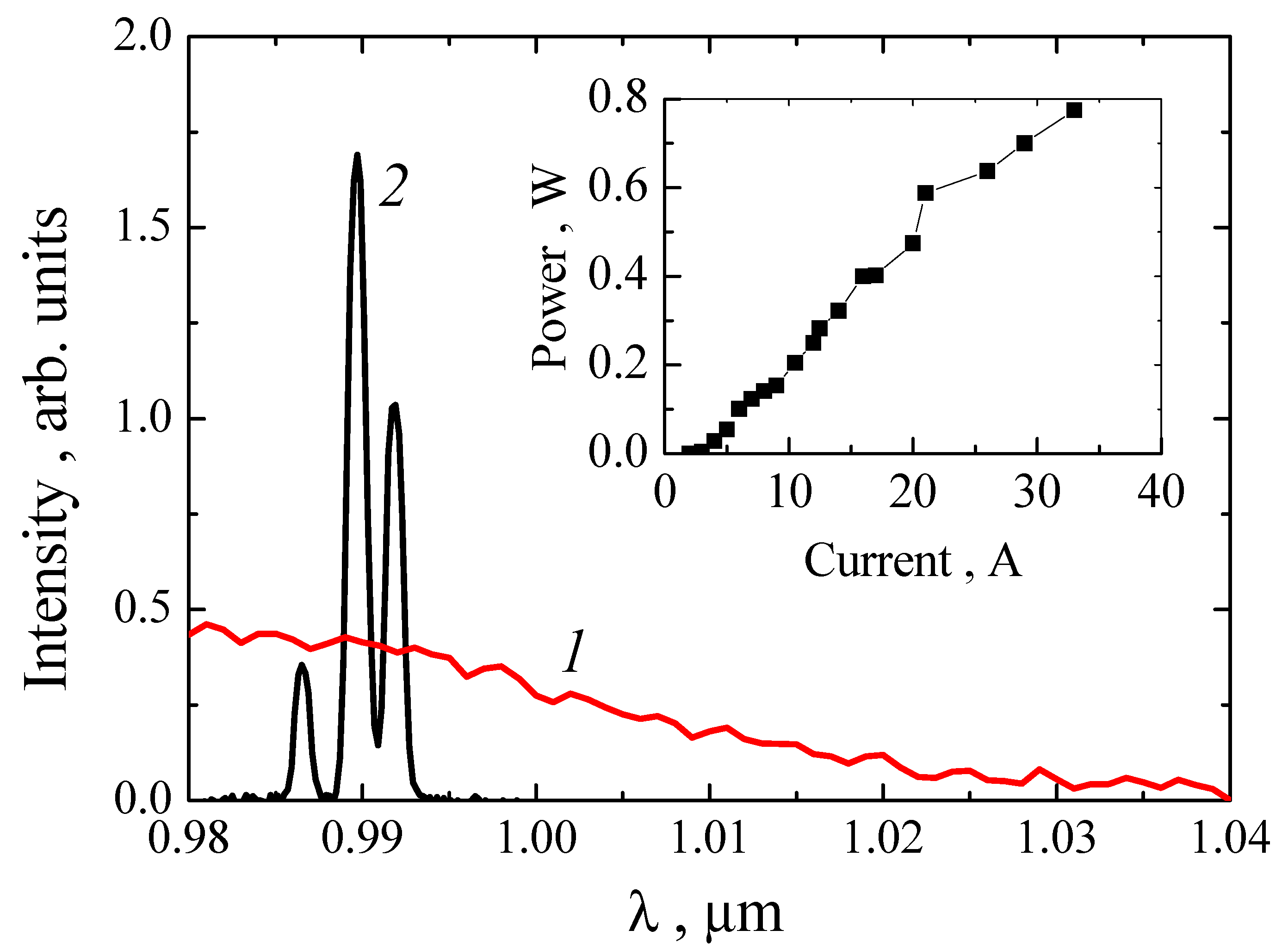
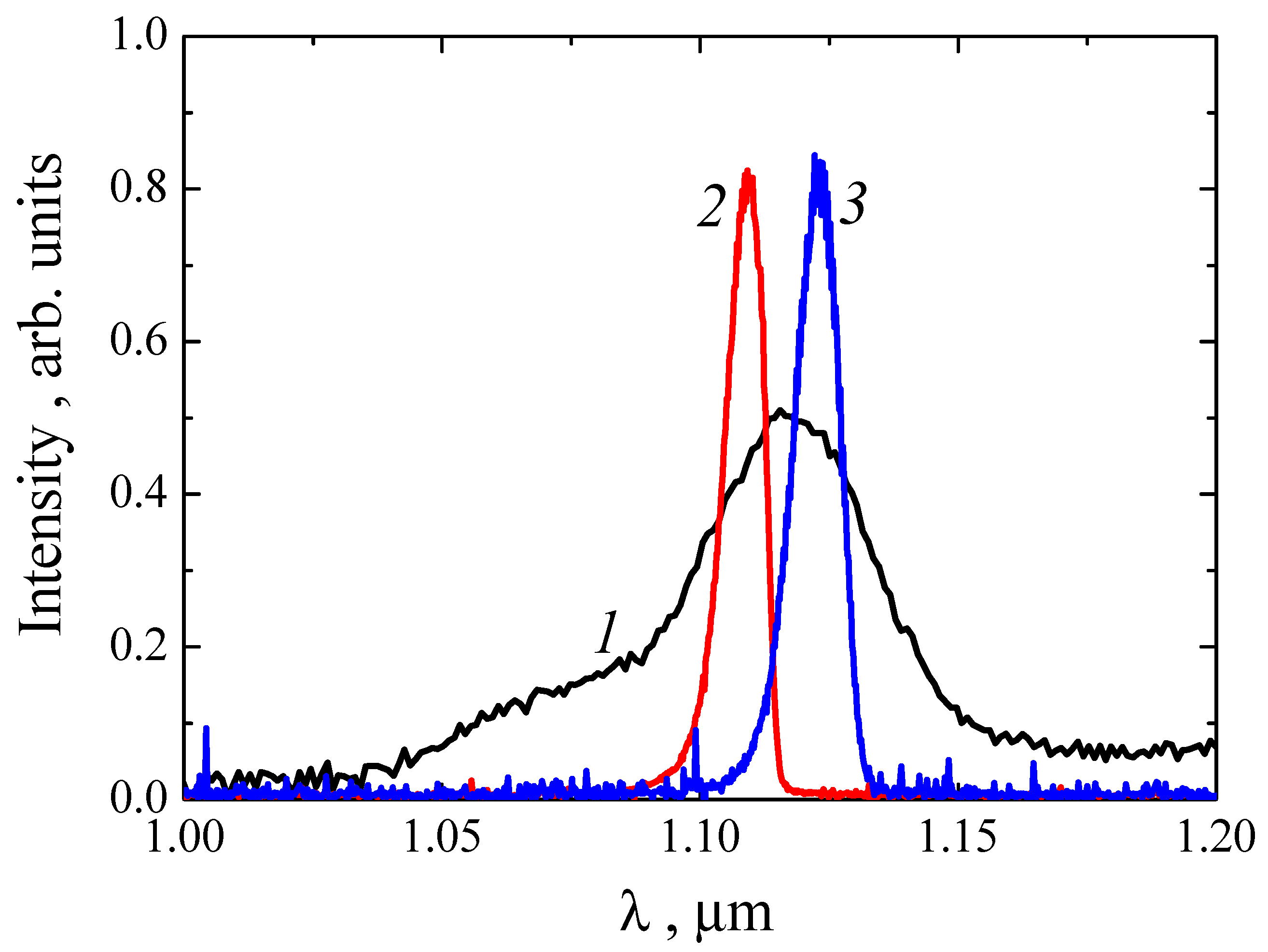
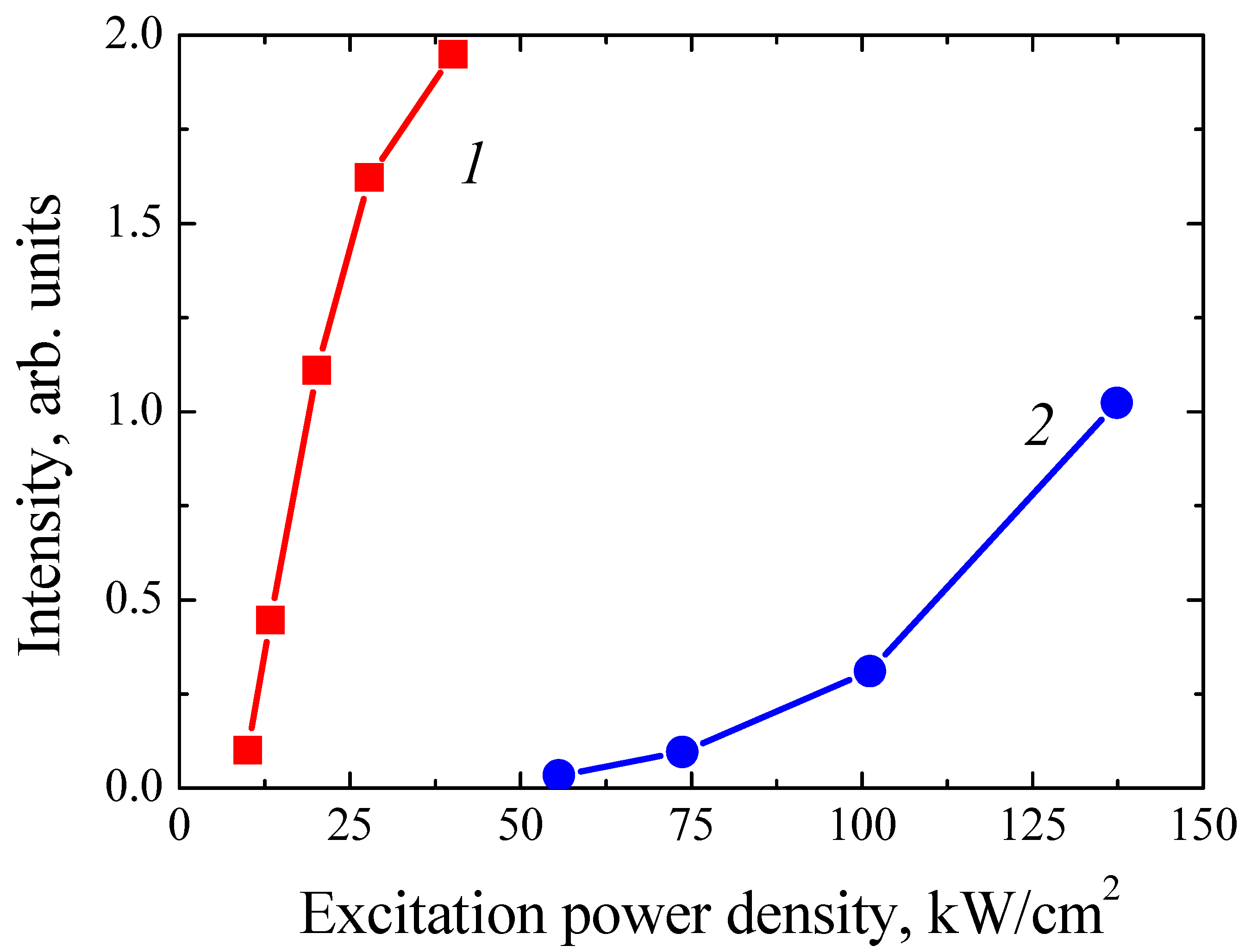
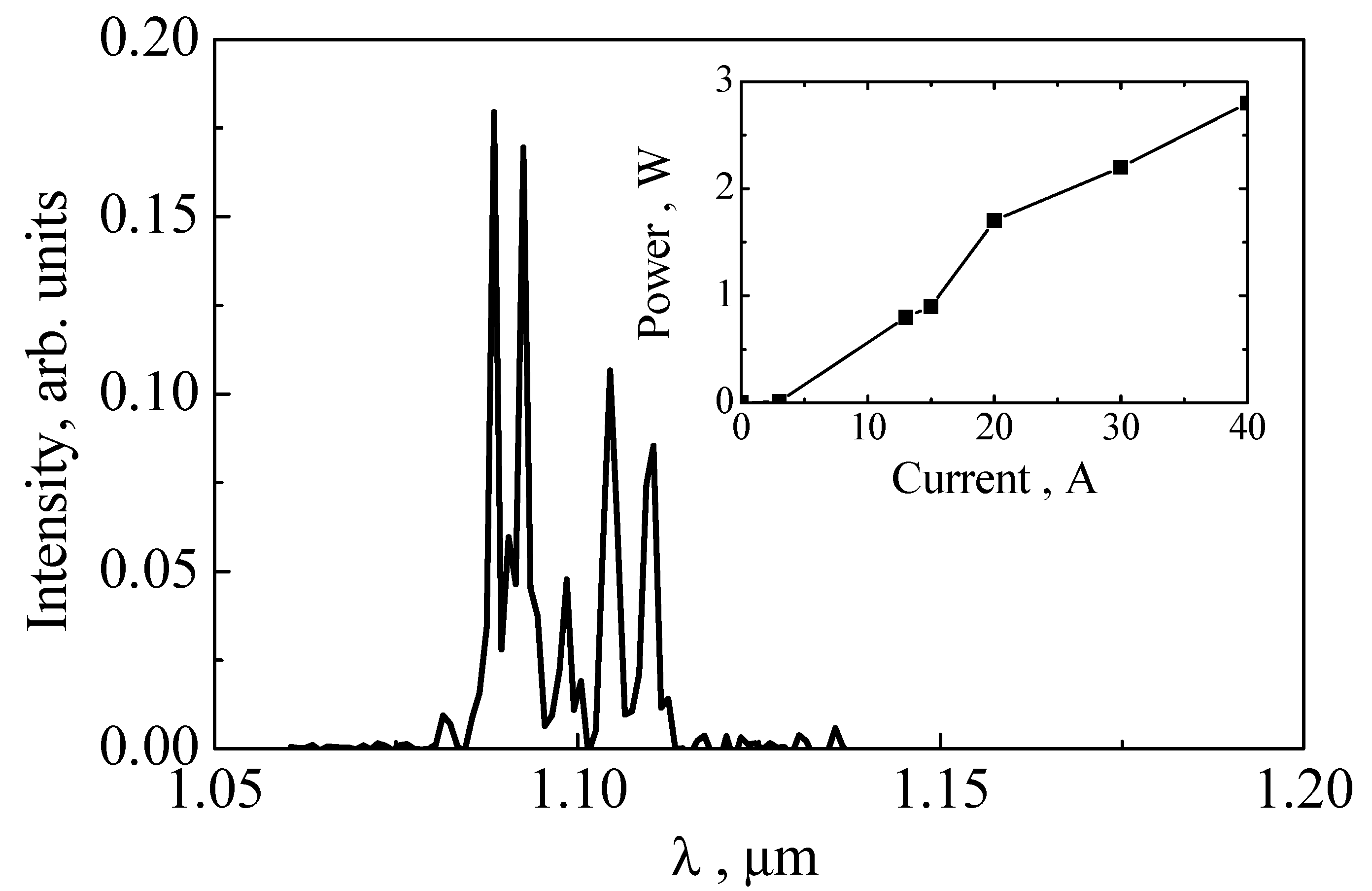
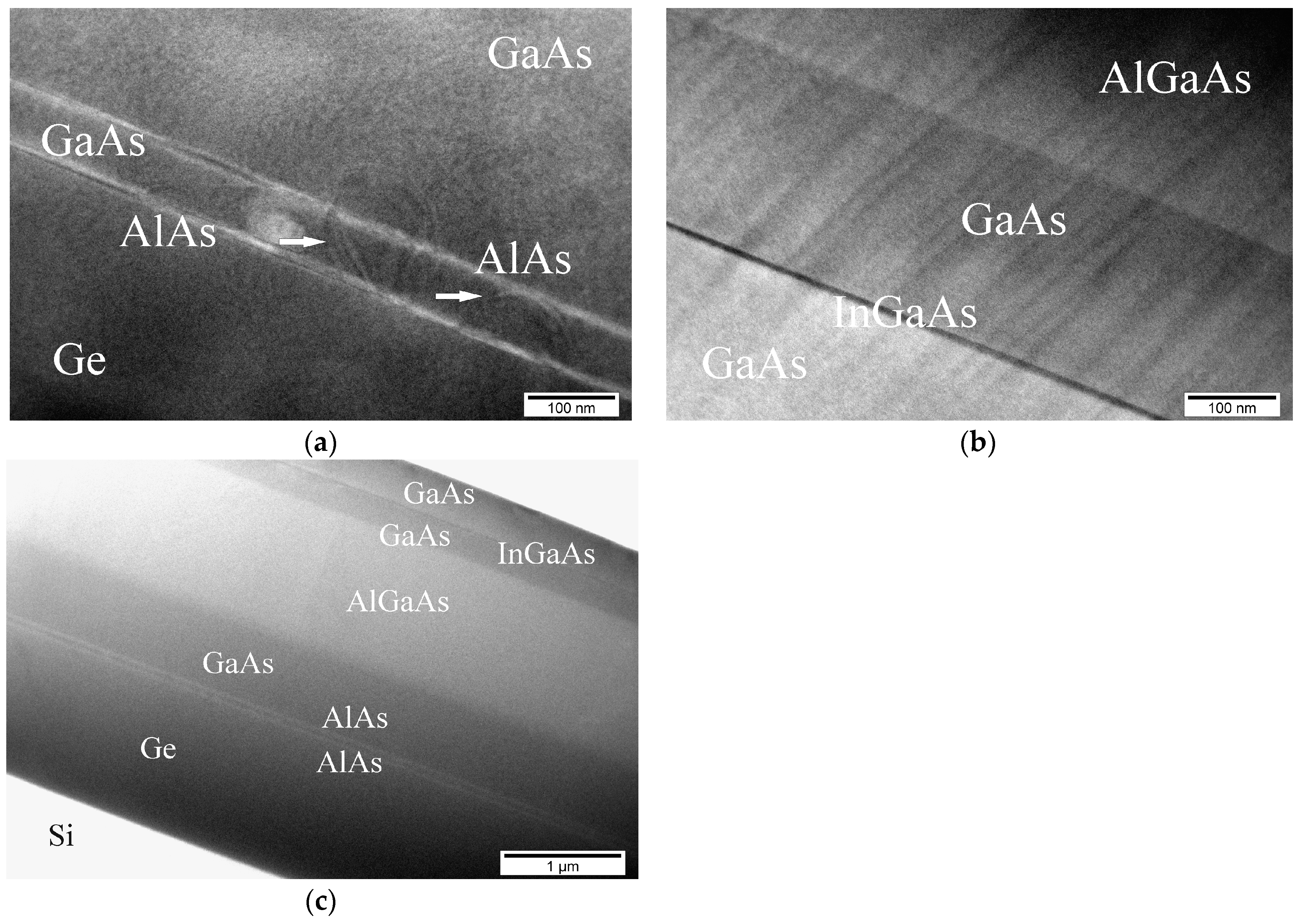
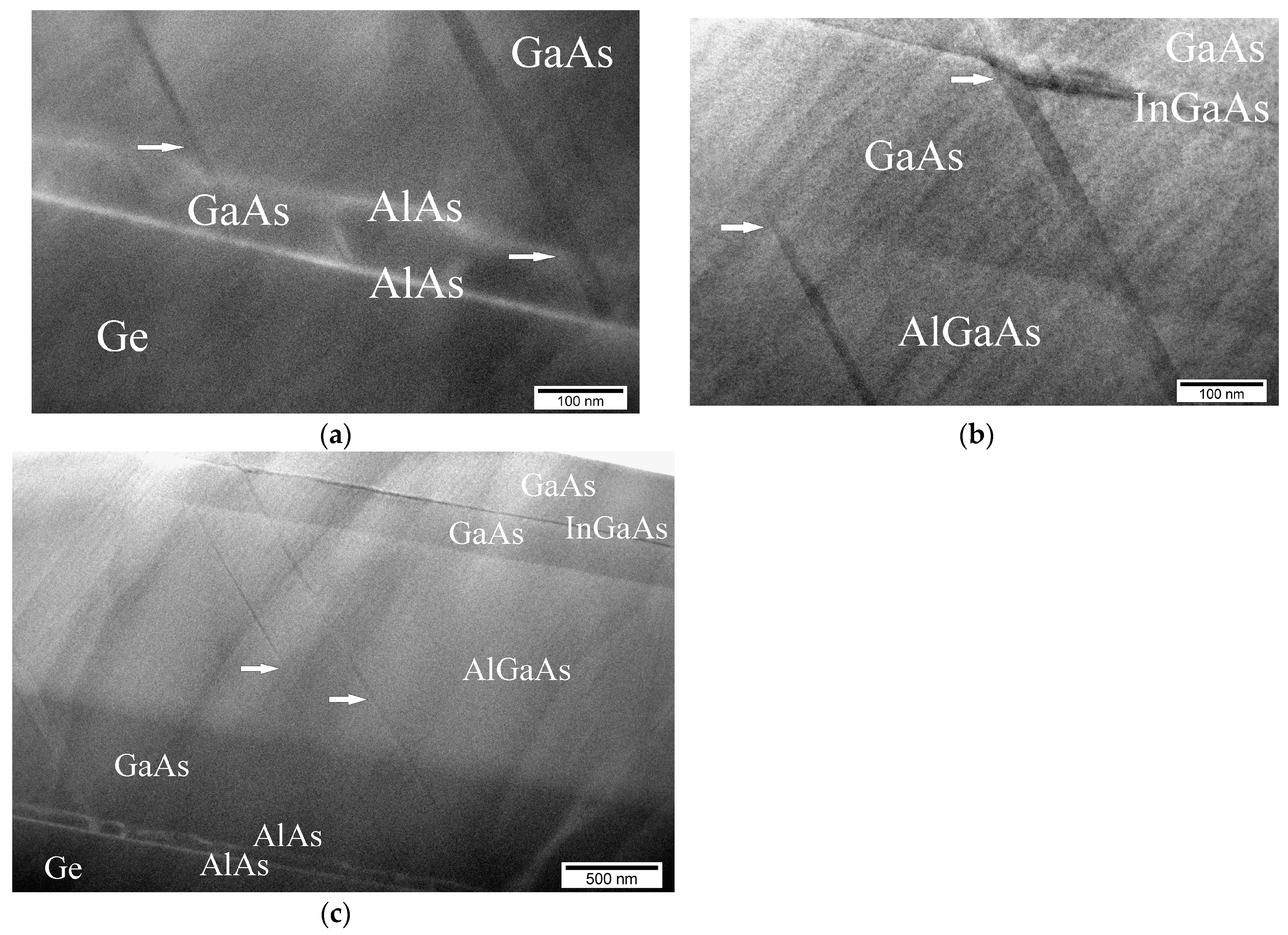
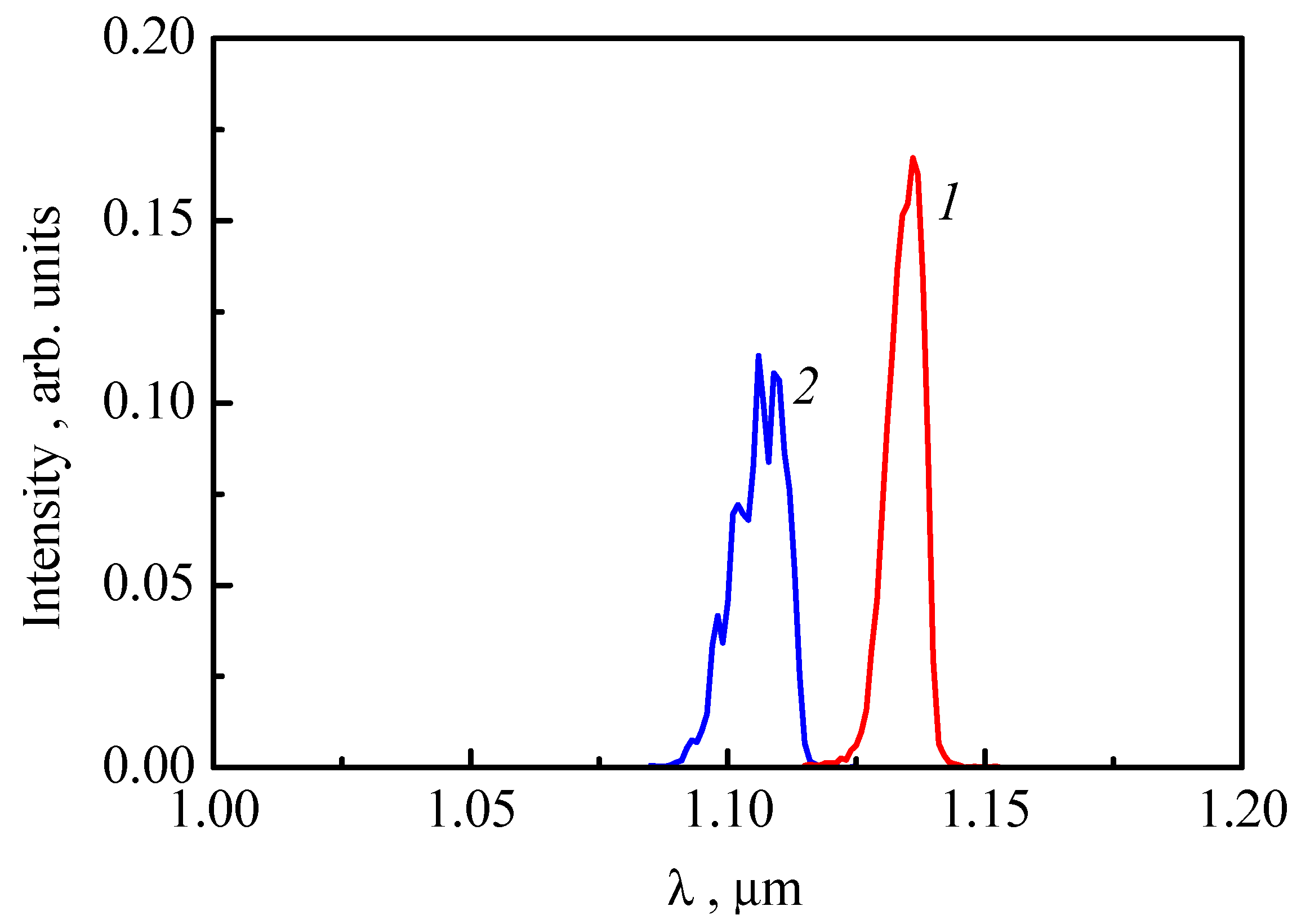
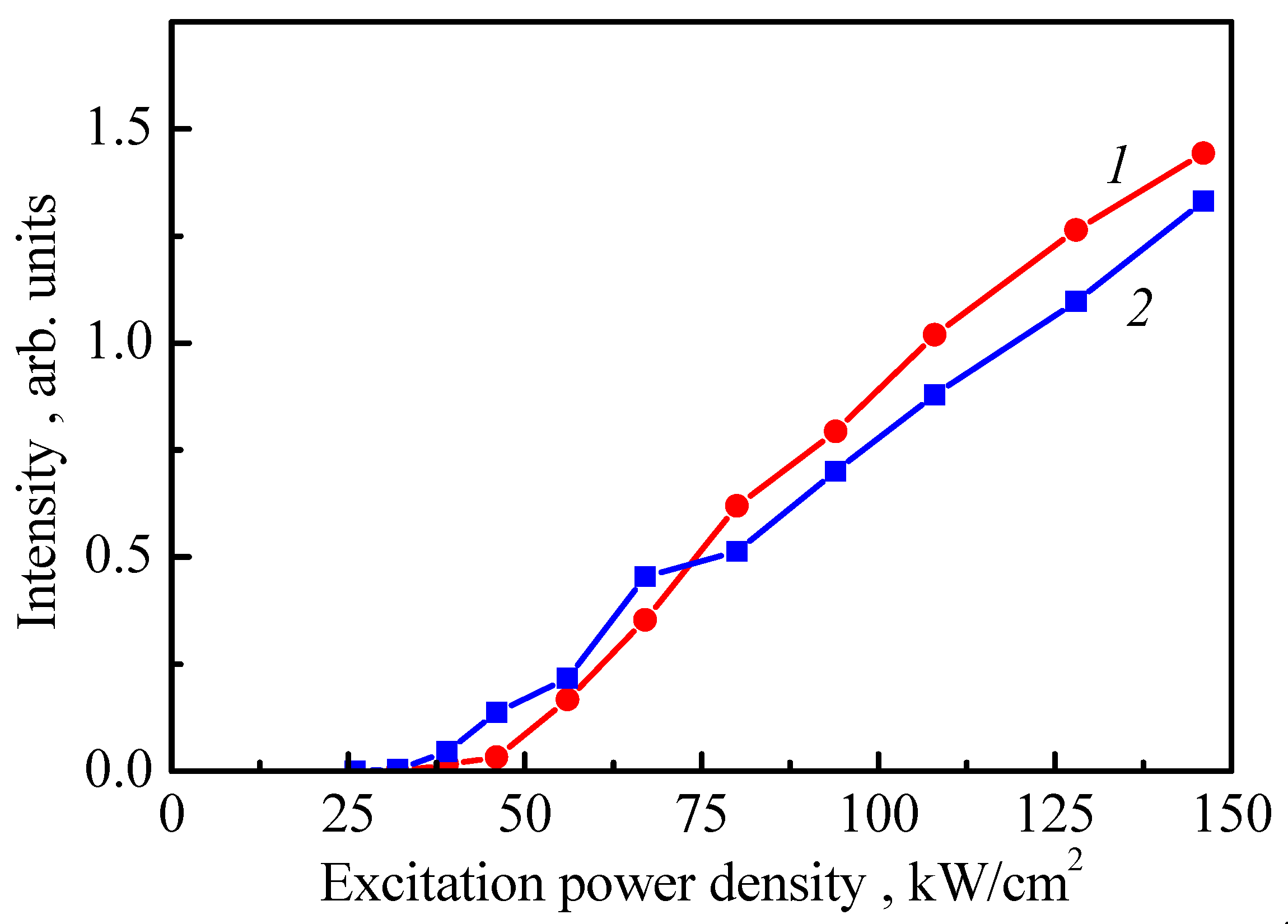
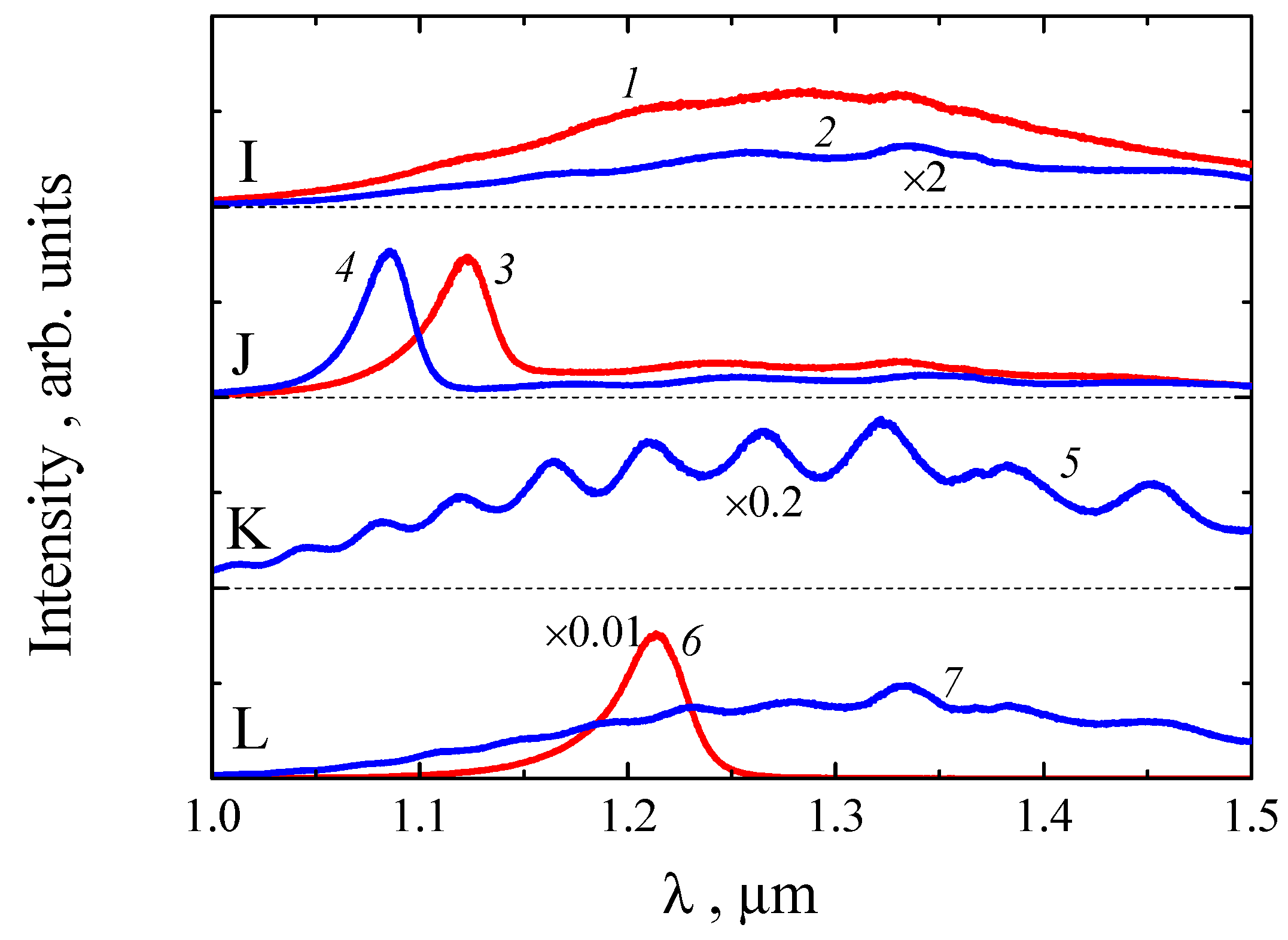
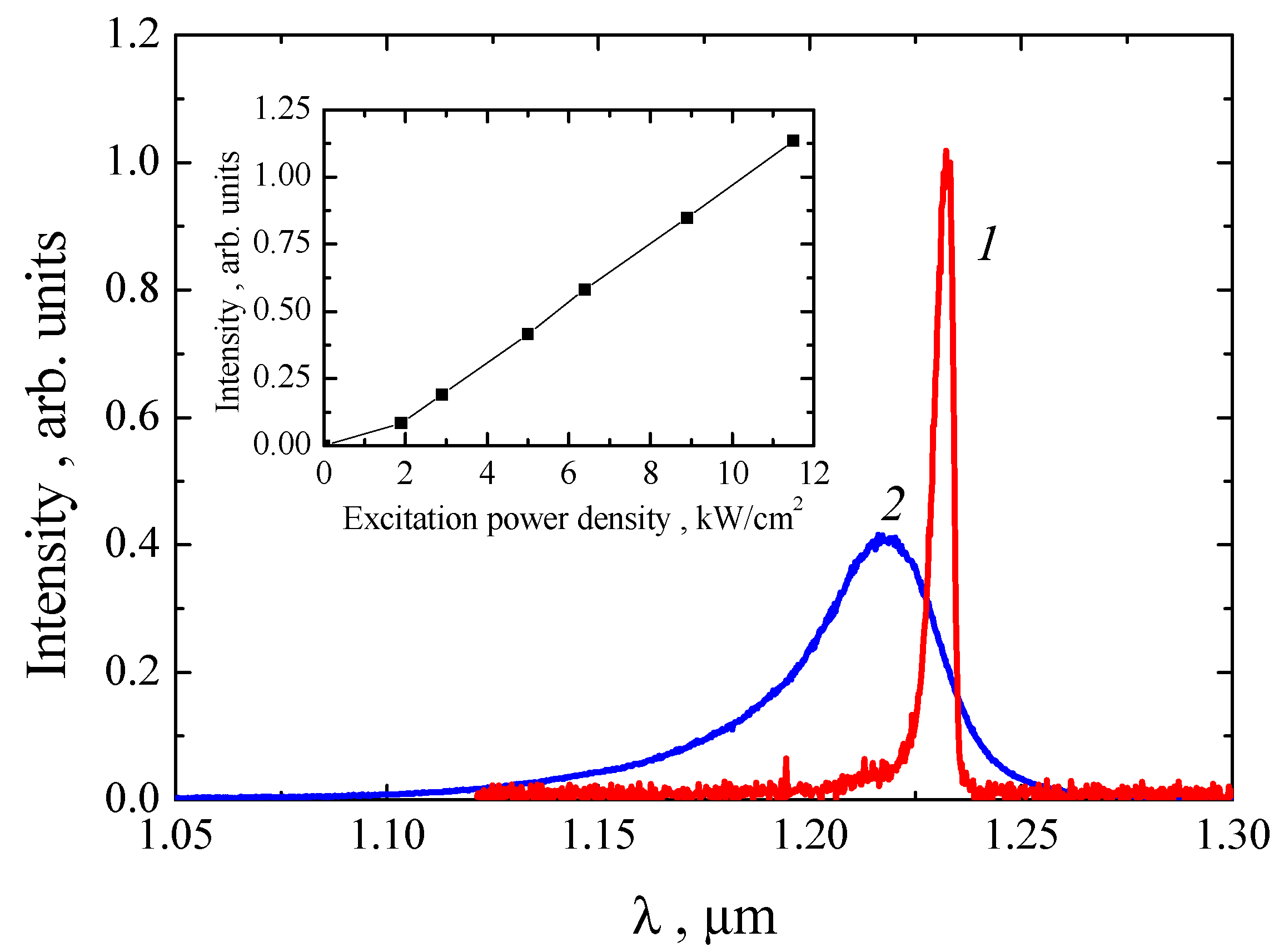
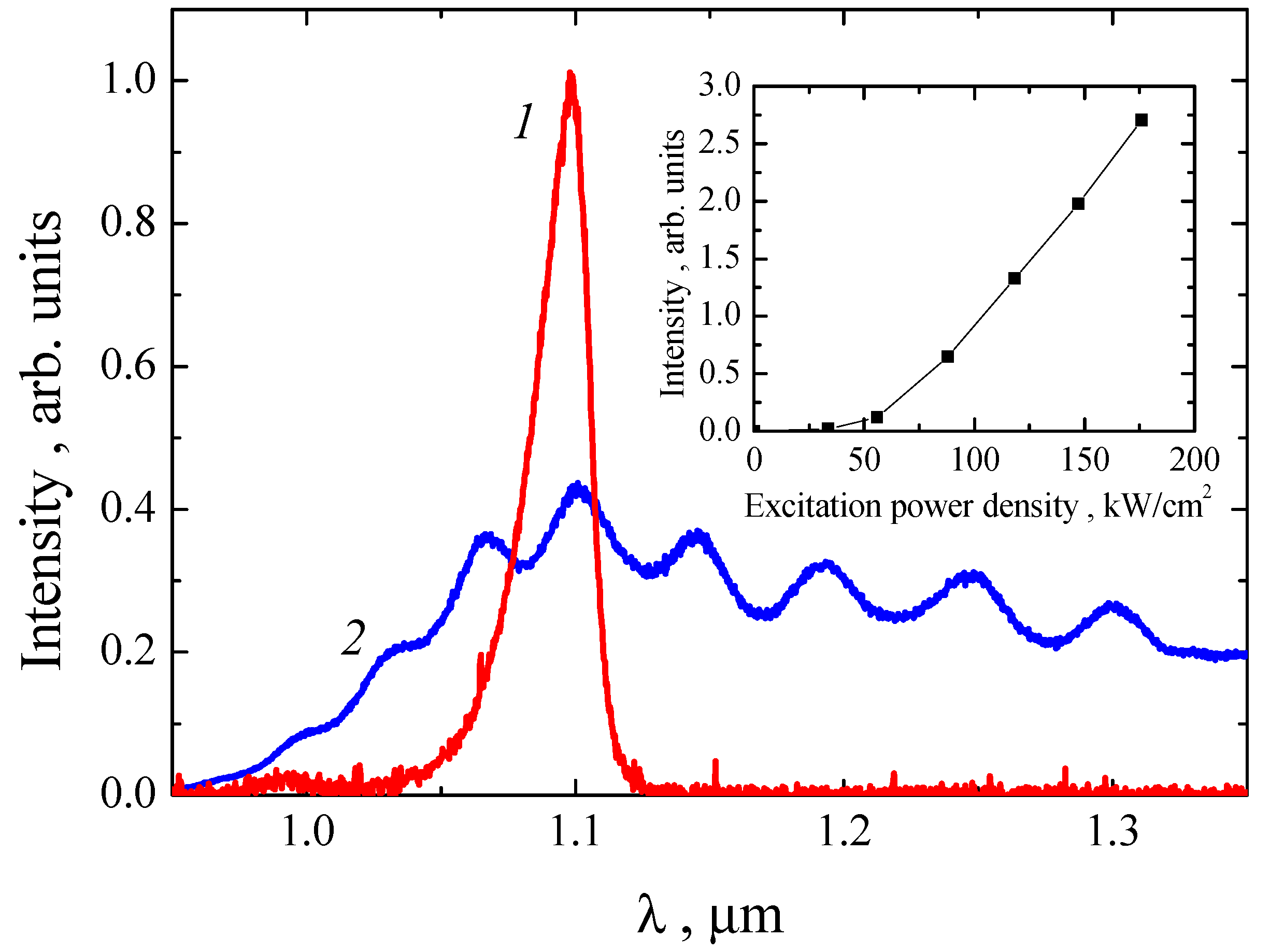
| Substrate Number | Offcut Angle | Ge Layer Thickness | RMS Roughness (Scan Area 13 × 13 μm) | Ge(004) Rocking Curve Width | Density of Threading Dislocations |
|---|---|---|---|---|---|
| 1 | <0.5° | 1 µm | 1 nm | 0.059° | ~107 cm−2 |
| 2 | <0.5° | 0.3 µm | 1.3 nm | 0.1° | (5–7)·108 cm−2 |
| 3 | <0.5° | 0.5 µm | 1.3 nm | 0.066° | (6–8)·107 cm−2 |
| 4 | 4° | 1 µm | 1 nm | 0.059° | ~107 cm−2 |
| Layer Number | Layer Composition | Layer Thickness, nm |
|---|---|---|
| 1 | AlAs | 10 |
| 2 | GaAs | 50 |
| 3 | AlAs | 10 |
| 4 | GaAs | 500 |
| 5 | gradient GaAs-Al0.3Ga0.7As | 100 |
| 6 | Al0.3Ga0.7As | 1000 |
| 7 | GaAs | 250 |
| 8 | InxGa1−xAs | 10 |
| 9 | GaAs | 350 |
| 10 | Al0.3Ga0.7As | 20 |
| 11 | gradient Al0.3Ga0.7As-GaAs | 10 |
| 12 | GaAs | 10 |
| x[In] | dQW, nm | x[P] | dCL, nm | Tgr, °C | |
|---|---|---|---|---|---|
| I | 0.39 | 7.5 | - | - | 600 |
| J | 0.4 | 8 | 0.11 | 10 | 600 |
| K | 0.43 | 7.5 | 0.14 | 12 | 530 |
| L | 0.44 | 9 | 0.125 | 15 | 530 |
© 2018 by the authors. Licensee MDPI, Basel, Switzerland. This article is an open access article distributed under the terms and conditions of the Creative Commons Attribution (CC BY) license (http://creativecommons.org/licenses/by/4.0/).
Share and Cite
Baidus, N.; Aleshkin, V.; Dubinov, A.; Kudryavtsev, K.; Nekorkin, S.; Novikov, A.; Pavlov, D.; Rykov, A.; Sushkov, A.; Shaleev, M.; et al. MOCVD Growth of InGaAs/GaAs/AlGaAs Laser Structures with Quantum Wells on Ge/Si Substrates. Crystals 2018, 8, 311. https://doi.org/10.3390/cryst8080311
Baidus N, Aleshkin V, Dubinov A, Kudryavtsev K, Nekorkin S, Novikov A, Pavlov D, Rykov A, Sushkov A, Shaleev M, et al. MOCVD Growth of InGaAs/GaAs/AlGaAs Laser Structures with Quantum Wells on Ge/Si Substrates. Crystals. 2018; 8(8):311. https://doi.org/10.3390/cryst8080311
Chicago/Turabian StyleBaidus, Nikolay, Vladimir Aleshkin, Alexander Dubinov, Konstantin Kudryavtsev, Sergei Nekorkin, Alexey Novikov, Dmiriy Pavlov, Artem Rykov, Artem Sushkov, Mikhail Shaleev, and et al. 2018. "MOCVD Growth of InGaAs/GaAs/AlGaAs Laser Structures with Quantum Wells on Ge/Si Substrates" Crystals 8, no. 8: 311. https://doi.org/10.3390/cryst8080311
APA StyleBaidus, N., Aleshkin, V., Dubinov, A., Kudryavtsev, K., Nekorkin, S., Novikov, A., Pavlov, D., Rykov, A., Sushkov, A., Shaleev, M., Yunin, P., Yurasov, D., & Krasilnik, Z. (2018). MOCVD Growth of InGaAs/GaAs/AlGaAs Laser Structures with Quantum Wells on Ge/Si Substrates. Crystals, 8(8), 311. https://doi.org/10.3390/cryst8080311





